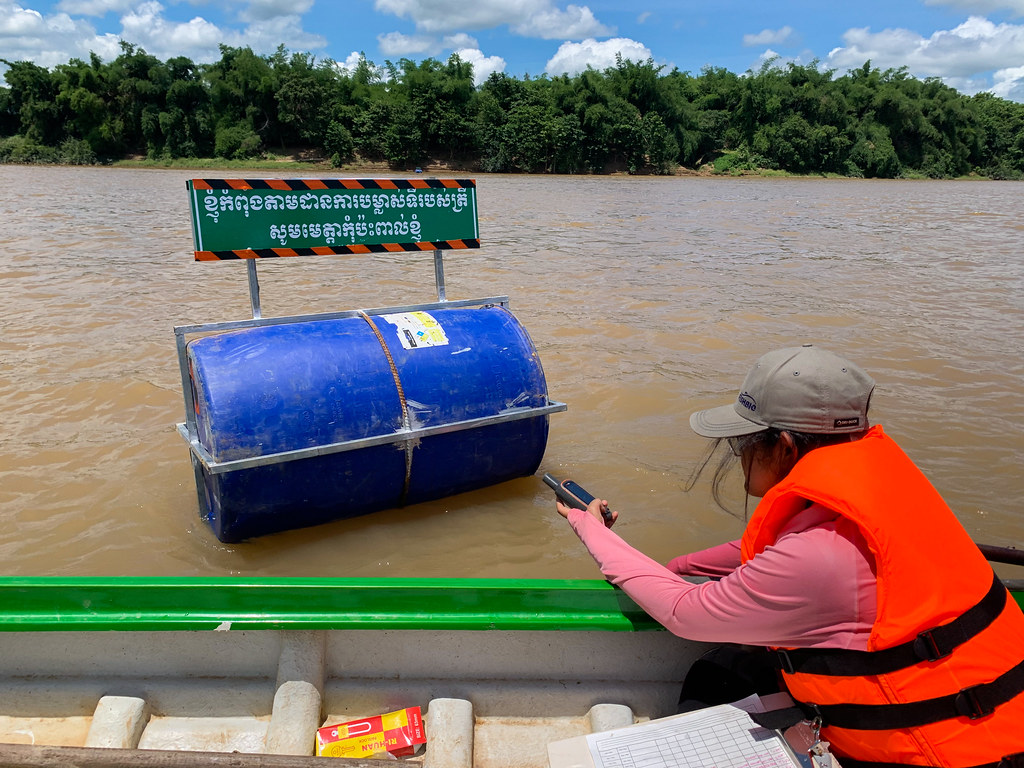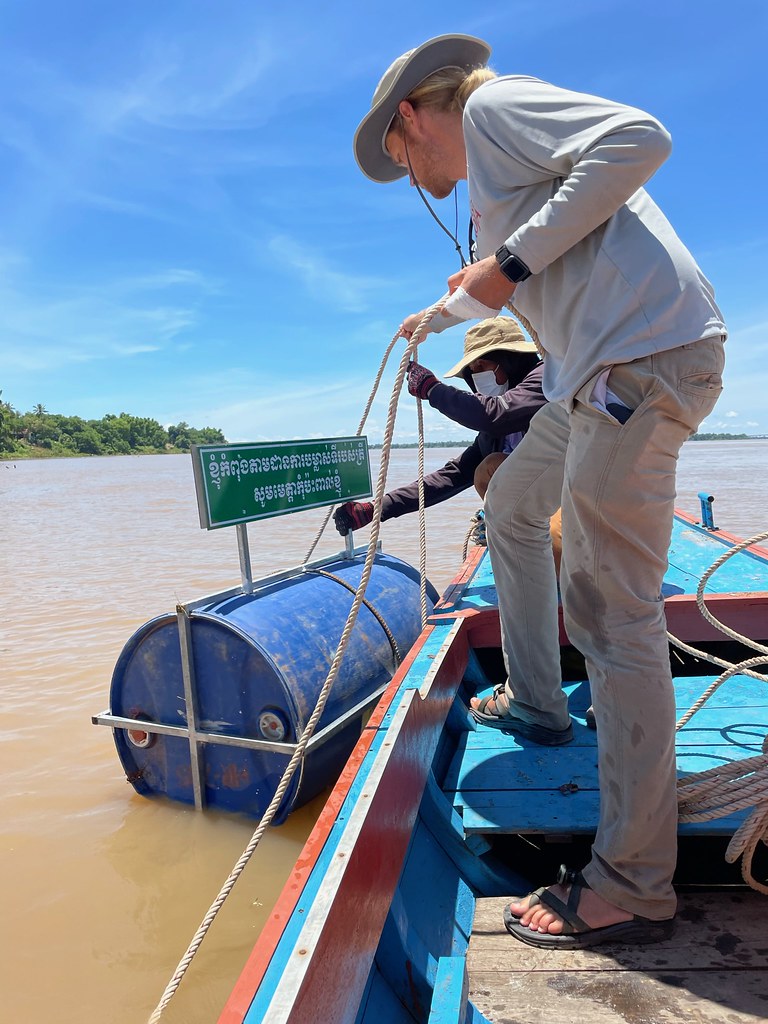Monday September 12, 2022

As part of an international effort to study the migratory behaviors of important Mekong fish species, FISHBIO has deployed the first ever acoustic telemetry receiver network in the Cambodian Mekong River. During a rigorous two weeks in the field, biologists from FISHBIO worked with collaborators from Young Eco (YEA) and officials from the Inland Fisheries Research and Development Institute (IFReDI) to deploy a network of acoustic receivers throughout the mainstem Mekong and in the Sekong, Sesan, and Srepok (3S) rivers of northeastern Cambodia.
In total, 36 acoustic receivers have been deployed throughout the Mekong River basin at locations with suitable channel structure – areas with deep water and no obstacles that might block the tag signals of passing fish – which were selected during scouting surveys conducted in early 2022. Four receivers were attached to existing docks and floating homes along the Mekong’s edge and 30 were mounted on floating platforms that were custom built by local communities. Floating platforms were constructed using plastic barrels or jugs, and were secured in place using lengths of rope attached to anchors on the river bottom. Another two receivers with acoustic release mechanisms were sunk to the bottom of the river, and will be retrieved at the end of the project by sending a sound signal to them that will trigger them to drop their anchors and float to the surface.
Collaboration with local communities along the Mekong has been a critical component of this acoustic telemetry study. FISHBIO, YEA, and IFReDI have conducted meetings with villages and local communities near the areas where receivers are being deployed. The purpose of these meetings was to inform locals about the study, as well as provide community members the opportunity to share their extensive knowledge of the region, including flooding patterns, key habitats, local knowledge of fish migration behaviors, and potential sources of healthy wild fish for future tagging efforts. Community members also played a crucial role in the construction and deployment of the receiver network, and will continue to monitor receiver stations throughout the wet season as debris and heavy flows make their way downstream.
During their trip to install the receiver network, FISHBIO opportunistically tagged a giant freshwater stingray (Urogymnus polylepis) weighing 300 kilograms and measuring 398 cm from the tip of its snout to the tip of its tail. This stingray, accidentally caught by a local fisher, is currently regarded as the largest true freshwater fish on record. Biologists from FISHBIO measured, weighed, surgically tagged, and released the ray in the vicinity of where it was captured. This stingray has since been detected by the new acoustic network, providing an exciting demonstration of the network’s ability to track fish in the region.
FISHBIO personnel are planning a fish tagging event for the start of the dry season in early December 2022, that will focus on tagging and releasing large numbers of fish in the Cambodian Mekong as well as the 3S rivers. Acoustic tagging of fish will continue for the lifetime of this study (through 2024), as each tag has a battery life of approximately one year.
The Mekong River is home to a wide diversity of migratory patterns expressed by the many different species of fish that reside there. Migrations range from short swims into seasonally flooded forests, to long distance journeys up and down the length of the Mekong River and even to the ocean. The purpose of this study is to improve understanding of fish migration timing, routes, and distances in the Mekong River basin, and identify the locations of critical habitat. This information may in turn help guide and target conservation of key spawning and rearing habitats, as well as important migratory corridors. The results from this study will be vital for ensuring essential habitat areas remain connected for fish to complete their life cycles.

A major focus of this study has been the collaboration with the Mekong River Commission’s Joint Environmental Monitoring (JEM) program, who have deployed a similar receiver network and are releasing tagged fish in Laos near the border with Cambodia. Early downloads of receiver data have already documented fish migrations between the two countries, and fish tagged in Laos have been detected as far downstream as Koh Snam Chey, about 26 miles (~42 km) south of the border. These detections emphasize the need for international cooperation in efforts to conserve Mekong fisheries. By sharing data collected from their respective receivers, FISHBIO and the JEM team may better understand how migratory fish populations are moving among the two countries, and how they are responding to hydrological changes from recently constructed dams in the area.
This research, funded by USAID, is part of the Wonders of the Mekong project, an international collaborative effort focused on conducting applied research, building capacity, and developing outreach to highlight the ecological, cultural, and economic values of biodiversity in the Lower Mekong River. By implementing acoustic telemetry to study fish migrations in the Cambodian Mekong, FISHBIO and project partners are contributing to the Wonders of the Mekong mission by providing a valuable first look at fish movement on an international scale. Understanding the impact that humans have had on the Mekong – and how migratory fish are responding to those changes – is crucial to ensuring sustainable fisheries and a functional ecosystem into the future.

Patrick O’Bryan contributed to this story as part of an internship with FISHBIO.
This post was featured in our weekly e-newsletter, the Fish Report. You can subscribe to the Fish Report here.
